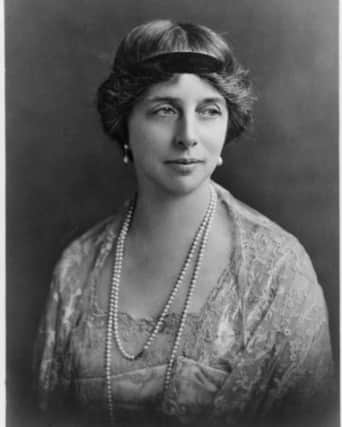The "Red Duchess" - Scotland's first female MP


She was the Perthshire aristocrat who became Scotland’s first female MP and shook up parliament with her high principles and disregard for old school tribal politics.
Katherine “Kitty” Murray, the Duchess of Atholl, joined the House of Commons in 1923 after winning the seat of Kinross and West Perthshire for the Conservatives.
Advertisement
Hide AdAdvertisement
Hide AdThought of as honest, incisive and serious, Atholl was to embark on a political journey that left her frequently at odds with her own party given her views on the Spanish Civil War and her opposition to the policy of appeasement against Nazi Germany.
Her career was also to be defined by humanitarian work, particularly during the military revolt against the Republican government in Spain.
Despite her dislike of the “Communist menace”, she was herself to become known as the Red Duchess by those superstitious of her support for both the families of those fighting in the International Brigades and victims of the conflict.
While casting aside the politics of left and right, Atholl believed in the right for the Republicans to legitimately govern and defend themselves.
She had toured Spain in 1937 as part of an all-woman delegation that visited Barcelona, Catalonia, Valencia and Madrid.
Later she became chairman of the National Joint Committee for Spanish Relief and wrote the book, Searchlight on Spain, in 1938.
The MPs interests were widespread and she was to become one of the first campaigners against female circumcision in Africa.
The Duchess, who was also an accomplished pianist and composer, proved to be a heavy weight and fearless operator - but her profile today remains relatively obscure.
Advertisement
Hide AdAdvertisement
Hide AdAccording to author Sheila Hetherington, Atholl had been encouraged to enter frontline politics by a number of high profile figures but faced reservations from King George V who was concerned about her ability to host her husband’s guests at Blair Castle should she win her seat.
Hetherington, who earlier wrote a biography of the Duchess, said: “She did not herself seek to stand for Westminster, but was invited and encouraged by some prominent individuals: Lloyd George, Lord Haldane, the chairman of the Unionists association in her constituency, and her husband, the Duke of Atholl.
“King George, however, disapproved and solemnly reminded her that she would be less able to perform her duties as the Duke’s hostess at Blair if she was at Westminster.
“She won the vote by a narrow margin. A local newspaper attributed her success to her own personal popularity.”
By the time she had taken her seat in Westminster, the Duchess had already reported on the dire state of health provision in the Highlands and Islands as part of the influential Dewar Committee, whose findings became the blueprint for the NHS in Scotland.
But despite her interest in women’s and children’s issues, she was a lone wolf among her female peers on one particular subject - votes for women.
In 1924, she was only female MP to oppose women’s suffrage at 21, arguing there was no widespread desire for the bill and that the suffragette movement had become too militant. Lady Astor, the first female MP to take their seat in Westminster, derided her as “Canute trying to keep the waves back.”
Later, her position changed and the Duchess would befriend Sylvia Pankhurst who was to publicly endorse her as an independent candidate in the 1938 by-election which she triggered after losing the support of her local party over her views on Nazi Germany.
Advertisement
Hide AdAdvertisement
Hide AdAmid a policy of appeasement against Hitler, the Duchess argued intensely that action was required after reading Mein Kampf in German. She later distributed accurate English translations in order to raise awareness of its true contents and the danger posed by the regime.
Such was her belief that she resigned her seat and stood as an independent, fighting almost entirely on this single issue.
A telegram from Stalin supporting the Duchess' campaign inflicted further damage to a campaign that was set against the vast resources of the Conservative Party. She lost the election by just 1,305 votes.
Her friend and campaign organiser Frieda Stewart said: “The challenge was one of principle against a whole party-political machine; and the Tories were determined that they were not going to be put in their place by one dissident individual, whatever her title.”
Murray, who authored several books, largely stepped away from the fray of public and political life following her defeat.
Following the death of her husband in 1942, she became Honorary Colonel of the Scottish Horse Regiment and also served as President of the Perthshire Branch of the Red Cross Society and Chairman of the British League for European Freedom.
She died in Edinburgh in 1960, aged 85, after falling from a wall.